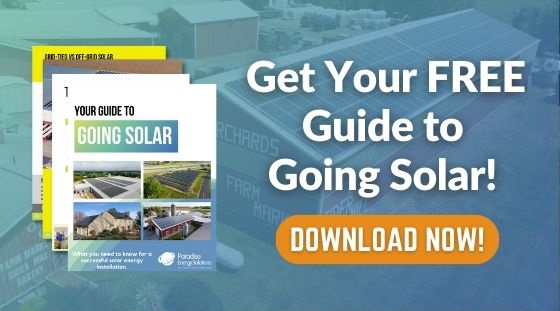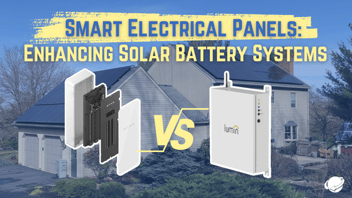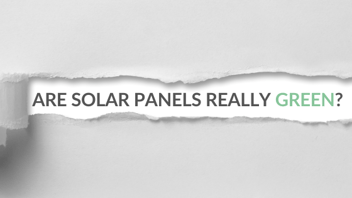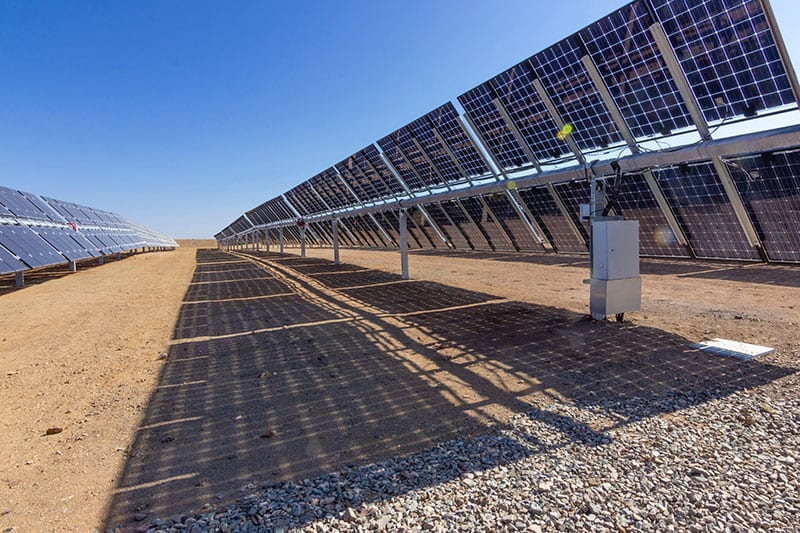
If you’ve ever driven past a building with solar panels lining the roof, chances are, they were single-sided or monofacial solar panels. With this type of PV module, sunlight hits the top face of the panel and then turns that energy into electricity.
But those aren’t the only kinds of solar panels out there. There’s another type—bifacial solar panels. While traditional solar panels have just one side of energy-producing solar cells, bifacial or double-sided solar panels have cells on both sides.
Given their double-sided nature, bifacial panels can generate electricity from both direct sunlight and from the reflected light bouncing back from underneath the panel. Diffused light from clouds, buildings, or other objects can also hit the back and generate electricity.
Bifacial solar panels can produce more electricity with the same number of solar panels. But are they better than monofacial solar panels? In this blog, we’ll take a deeper look into this technology, going over the following topics:
- How Do Bifacial Solar Cells Work?
- Who Should Use Bifacial Solar Panels?
- How Much More Electricity Do Bifacial Panels Produce?
- How Much Do Bifacial Solar Panels Cost?
- Are Bifacial Solar Panels Widely Available?
- Bifacial Solar Panels vs. Monofacial Solar Panels
How Do Bifacial Solar Panels Work?
If you’re familiar with how solar panels work, you’ll know that silicon cells capture photons from sunlight and convert them to energy. These cells are held together in a frame, sandwiched between a protective glass coating and an opaque back sheet. 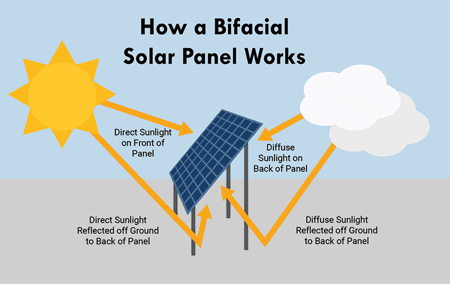
However, when it comes to bifacial solar modules, the opaque back sheet is switched for a clear back sheet. This allows photons from reflected and diffused light to hit the back of the panel and generate power.
To optimize the amount of energy produced by the backside of the panel, shading caused by obstructions like the panels’ racking system needs to be minimized. In a traditional ground mount system, horizontal and vertical support bars are used to support the solar panels.
However, because this traditional racking takes up valuable electricity-producing real estate on the backs of bifacial panels, these systems often have different mounting systems. The support rails across the back are thinner, and there are fewer vertical support poles.
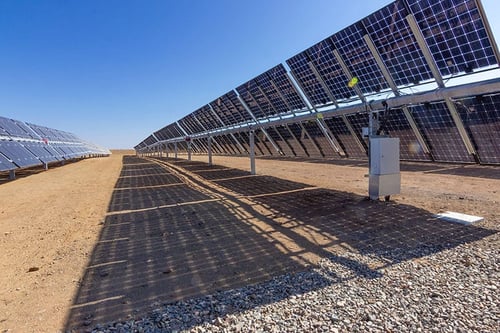
Who Should Use Bifacial Solar Panels?
Bifacial panels can generate more electricity than monofacial panels with the same space. If you’re limited on space, opting for bifacial panels can help your system produce more electricity with fewer panels. However, bifacial panels aren’t for every solar-powered home and business. There are a few factors that impact how much your bifacial system will produce.
Tilt Angle
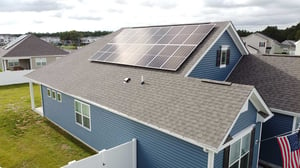 The more vertical the bifacial panels are tilted, the more light will reach the backside, producing more energy. Because of this, bifacial panels often perform the best as ground mounts or as raised mounts on flat roofs, making them a good option for many commercial and utility-scale systems.
The more vertical the bifacial panels are tilted, the more light will reach the backside, producing more energy. Because of this, bifacial panels often perform the best as ground mounts or as raised mounts on flat roofs, making them a good option for many commercial and utility-scale systems.
Bifacial panels installed on tilted roofs are often not ideal because the panels are flush against the roof, leaving little to no room for light to get to the rear side. As many homes have sloped roofs, bifacial solar panels are not commonly used on residential solar systems. However, if you want to install a ground mount system, solar carport, or solar pergola, bifacial panels may make sense.
Surface Reflectivity or Albedo
Another critical factor for the success of bifacial panels is the reflectivity or albedo of the surface below the panels. Albedo is how much light is reflected by a surface. An example of something with a high albedo is snow, whereas black asphalt would have a lower albedo.
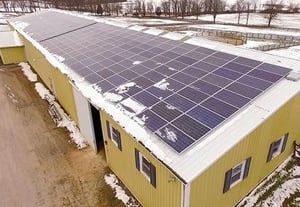 Bifacial panels love surfaces with high albedos because they’ll take all that reflected sunlight and turn it into energy. Metal roofs are often great reflectors of light, as are cool roofs. Cool roofs can have an albedo of 0.65, or 65%, light reflecting back. So not only do they help you save energy and cooling costs, but they also make an excellent match for bifacial panels.
Bifacial panels love surfaces with high albedos because they’ll take all that reflected sunlight and turn it into energy. Metal roofs are often great reflectors of light, as are cool roofs. Cool roofs can have an albedo of 0.65, or 65%, light reflecting back. So not only do they help you save energy and cooling costs, but they also make an excellent match for bifacial panels.
If you’re considering a ground mount, grass and soil often have a lower albedo than cool roofs but still offer some reflectivity. To increase the albedo of the land below, you can install high-albedo mats or light-colored stone or gravel.
However, one of the most reflective naturally occurring materials is snow. If you live in an area that gets a lot of snow, bifacial panels will keep on producing even if the front of your system stays covered.
While solar panels are designed to shed accumulated snow, you will lose out on production while they’re covered. However, with bifacial panels, sunlight reflected off the snow on the ground means your panels will keep generating electricity from the backside as the snow above melts.
Bifacial Solar Panels' Efficiency
The main advantage of bifacial panels is the additional production. While most properly designed bifacial solar systems should produce more electricity than a monofacial system, don’t expect production to double. Because the backside is using reflected energy, it will inevitably produce less than the front side that’s receiving direct sunlight.
Because there are so many factors, like installation angle and surface albedo, it’s hard to give a solid estimate on how much extra electricity bifacial panels will generate. Most sources say you could see an increase in energy production between 5% and 30%.
How Much Do Bifacial Solar Panels Cost?
Bifacial solar panels do cost more than traditional monofacial panels. According to a 2019 study by NREL, the price difference between monofacial and bifacial panels ranges from $0.01 to $0.05 per watt for large projects, typically utility-scale. Installation costs for smaller commercial or residential systems will be closer to $0.20 per watt.
But can bifacial panels make up for their extra cost with extra production? If you’re trying to offset your home or business’s electricity, you’ll need fewer solar panels if you go with bifacial and install them in a way that maximizes their efficiency. Your solar installer will help guide you through the decision based on the characteristics of your property and your goals for the project.
Additional Resource: This is the price you can expect to pay for a solar energy installation.
Are Bifacial Solar Panels Widely Available?
In 2012, the Seattle Mariners installed a 32.76 kW solar system at their Major League Baseball stadium as part of the first 1 megawatt (MW) of bifacial solar installed worldwide. Since then, nearly 15,000 MW of bifacial solar panels have been installed as of 2021.
While monofacial panels still make up most solar systems installed today, that could steadily shift as bifacial panel technology becomes more available. While you may find it difficult to find many installers that install bifacial panels this year, all signs point to that changing as they gain more popularity.
Bifacial Solar Panels vs. Monofacial Solar Panels
So the question remains—should you install bifacial or monofacial solar panels? To wrap things up, we’ll look at the pros and cons of installing bifacial solar panels and how they compare to their single-sided counterparts.
One of the biggest benefits of bifacial solar panels is producing more solar energy with each panel. So if you’re looking to optimize the amount of electricity you can generate per square foot of space, bifacial panels have the edge.
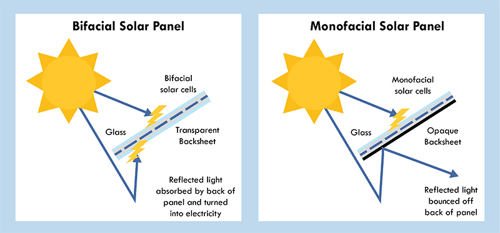
However, there are a few disadvantages of bifacial solar panels that could hinder the amount of extra electricity they produce. They can’t be installed as a typical roof-mounted system that’s flat against your roof. There needs to be some space between the backside of the panels and the surface below to reach the reflected light.
In addition, the row spacing between the panels will have to be specifically configured to ensure the shadows the panels cast won’t block light from reaching the underside of the panels. And the surface upon which they’re installed should have a high albedo to get more light to the panels.
So while monofacial or traditional panels may not have the ability to produce as much electricity as bifacial solar panels, there are still some advantages. Monofacial panels can be installed as conventional roof mounts or on a surface with low albedo.
Monofacial panels will likely be more affordable and available, as finding a solar company that installs bifacial panels can be tricky in some areas.
That said, both bifacial and monofacial solar panels can be a great investment. Most trusted panel manufacturers offer warranties that last 25 years to 30 years, and the panels could go on producing electricity long after the warranties expire. They'll provide you with a long-lasting way to produce cost-free and emissions-free electricity!
Let our team of solar experts help you select the best panels for your solar investment. Request a quote to get started.
In the meantime, visit our other educational blog post or download our solar buying guide.
Originally posted on 12/23/2019. Updated on 10/13/2021.

